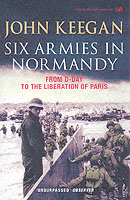
Six Armies in Normandy
John Keegan
365 pages, including index
published in 1982
John Keegan is one of the best military writers I have encountered so far. Every book I've read of his has been a pleasure to read. He has the knack of writing about military matters for a lay audience without either being patronising or obscure. He also manages to strike the right balance between telling about abstract, high order strategy and the face of a battle as experienced by those involved in it. Last, but not least, he is well aware of the endless fascination and terrible appeal war and warfare can have without glamourising it.
Six Armies in Normandy is no exception. This was an excellent book, a look at the Normandy campaigns by way of comparing and contrasting the six different armies that took part in it: the American, British, Canadian, French, Polish and German, Keegan using "armies" here in the sense of a national army, rather than as a specific type of military unit. It is not intended as a full chronicle of the D-Day landings and the campaign in Normandy and you will need some prior knowledge of them to make the most of this book. However, Keegan still includes enough context for the stories in this book to make sense and in the end you still get a rough history of the war in the west from D-Day to the liberation of Paris.
After a long introductionary chapter that describes how and why the D-Day landings came to be, Keegan takes a look at each of the participating armies in turn, by describing a single action in which a representative unit of said army excelled itself. For the Americans, the airborne landings of the 101st Airborne Division on the eve of D-Day were taken, while the Canadians are represented by the 3rd Canadian Division on D-Day itself, landing at Juno. The British army is represented by two units, the 15th Scottish Division during Operation Epsom, the drive to capture Caen and the English 11th Armoured Division during Operation Goodwood, breaking out east of Caen. This is followed by a chapter devoted to Operation Cobra, the breakout of the American forces from Cotentin peninsula, which focuses on the German defence and Operation Lüttich, the German counterattack.
At the end of these operations, most of the german armies in Normandy were now bottled up around Falaise, almost completely surrounded. It is now the Polish 1st Armoured division Keegan follows in the story of the closure of the Falaise pocket. Finally, the story is concluded by the liberation of Paris by the Free French 2nd Armoured Division, followed by a quick recap of the rest of the war after it.
Each chapter is embedded in the bigger context of the campaign enough to not float in a vacuum and in all, you get a selective but highly readable account of the fighting in Normandy. Six Armies in Normandy is a book that is accesible to lay persons like myself, but offers enough meat even for those who already know much about the Normandy campaigns as well.
